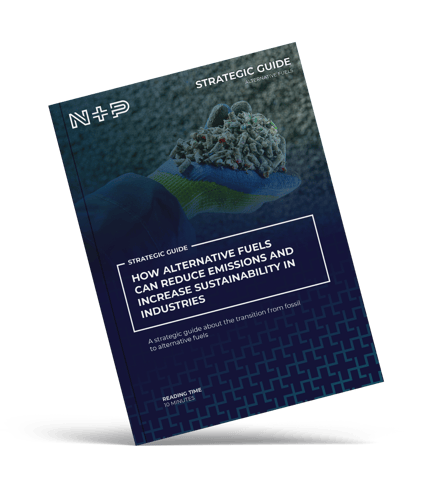SRF a renewable energy source
Solid Recovered Fuel: A Sustainable Alternative to Replace Fossil Fuels
Solid Recovered Fuel (SRF) is an alternative fuel that is derived from waste materials, which have been processed into a high-energy fuel. SRF is produced by sorting and processing non-recyclable waste materials containing plastic and biogenic materials such as paper, textile and wood, offering an alternative to landfill and the use of fossil fuels.

What is Solid Recovered Fuel (SRF)?
SRF is an alternative to fossil fuels such as coal, oil, and gas, and can be used in cement, lime and steel kilns, power plants and other industrial applications. SRF has a higher energy content than many traditional fuels. Solid Recovered Fuels contribute to reduce greenhouse gas emissions, reliance on fossil fuels and preventing waste to go to landfill.
The production of Solid Recovered Fuel (SRF)
The production of SRF begins with the sorting of waste materials. This can include municipal solid waste, industrial waste, construction waste, and commercial waste. Harmful materials such as PVC, stone, metals and glass are sorted out and return to recyclers.
The resulting waste is sorted into different categories, such as paper, plastic, and wood, and any non-combustible materials are removed. The materials are then shredded and dried to reduce the moisture content.
Once the materials are dried, they are processed to remove any remaining contaminants, such as metals or glass. This is important to ensure that the final product is of high quality and does not contain any harmful substances. The resulting material is then shipped or stored or can be further processed into pellets.
Key benefits of using SRF as a renewable energy source
SRF has a number of advantages over traditional fossil fuels. It is a renewable energy source, meaning it can be produced indefinitely, unlike fossil fuels, which are finite resources. SRF also has a lower carbon footprint than many traditional fuels, as the production process produces fewer greenhouse gas emissions than the extraction and processing of fossil fuels because of its biogenic content.
In addition to its environmental benefits, SRF also has economic benefits. The production of SRF creates jobs in the waste management and energy sectors and can provide a reliable energy source for many different energy consuming industrial processes worldwide.
Adoption of SRF in Europe and beyond
SRF has been widely adopted in Europe, where strict environmental regulations have driven the development of the waste management industry. In recent years, there has been growing interest in SRF in other regions, such as North America and Asia, as more companies and governments seek to solve national waste problems, reduce their reliance on fossil fuels and move towards more sustainable energy sources.
In conclusion, SRF is a high-energy fuel that is produced from waste materials, which have been processed to remove contaminants and compressed into dense pellets. SRF offers a renewable and sustainable alternative to fossil fuels, reducing greenhouse gas emissions and providing a reliable source of energy for industrial processes. With growing interest in sustainable energy sources, the use of SRF is likely to continue to expand in the coming years.
What is the difference between RDF and SRF?
Though both these fuels derive from the same initial materials, the degree of refinement distinguishes them. Solid Recovered Fuel (SRF) typically undergoes a high level of purification, generally produced in line with the precise specifications of the companies that will consume it. On the other hand, Refuse-Derived Fuel (RDF) demands a lesser degree of refinement to meet the final users' requirements.
However, the boundary between the traditionally defined RDF and SRF is increasingly becoming vague as new processing technologies emerge. These require a fuel with characteristics that lie in between what was formerly labeled as RDF and SRF.

Ready to replace fossil fuels?
Read about reducing CO₂ emissions and discover a new perspective on decarbonizing global industries.
We repurpose waste
into sustainable resources.